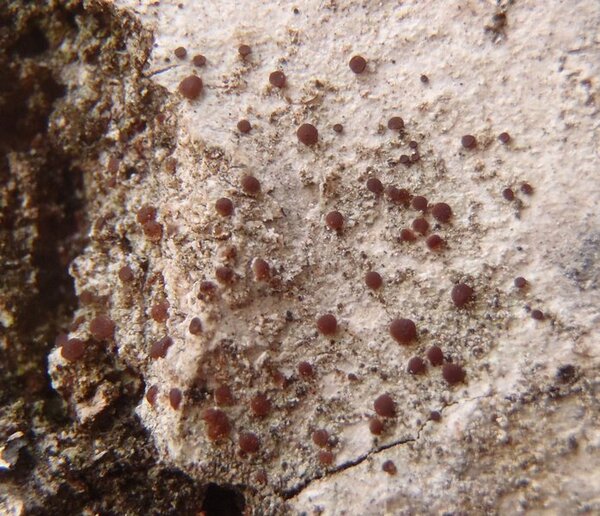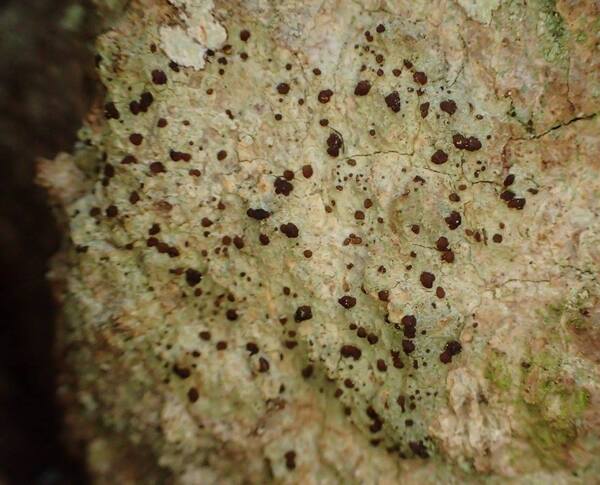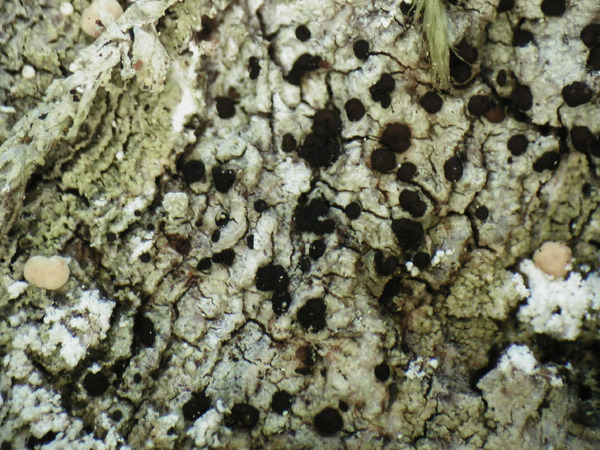Lecidea erythrophaea Sommerf.
Flörke ex Sommerf., Suppl. Fl. Lapp.: 163, 1826.
Synonyms: Biatora alnicola Anzi; Biatora erythrophaea (Sommerf.) Fr.; Lecidea alnicola (Anzi) Jatta; Lecidea cupuliformis (Räsänen) H. Magn.?; Lecidea hyalinella (Körb.) Jatta; Lecidea minuta (Schaer.) A. Massal.; Lecidea tenebricosa auct.
Description: Thallus crustose, endosubstratic or thinly episubstratic, continuous to rimose, pale grey or greenish grey. Medullary hyphae I-. Apothecia biatorine, rounded to slightly irregular in outline, rarely tuberculate, adnate to sessile and constricted at base, 0.25-0.7(-1) mm across, with a ochre to reddish brown (in older apothecia sometimes almost black), flat to slightly convex disc and a concolorous or usually slightly darker, soon excluded proper margin. Proper exciple pale brown in outer part, colourless or with small pigmented droplets within, 25-60 µm wide laterally, 35-85 µm wide at base, of radiating hyphae with swollen end cells; epithecium reddish brown, 5-10 µm high, K-; hymenium colourless to pale yellowish brown, 35-55(-70) µm high, I+ blue; paraphyses simple or sparingly branched and anastomosing, 0.7-2 µm thick at mid-level, the apical cells 2.5-5 µm wide, with a brown cap; hypothecium colourless or very pale brown, 45-125(-170) µm high. Asci 8-spored, distinctly thickened at the apex, with a I+ blue tholus, the outer gelatinous coat I+ pale blue, approaching the Bacidia-type. Ascospores 1-celled, hyaline, fusiform, (7-)9-15(-18) x 3-4(-5) µm. Photobiont chlorococcoid. Spot tests: thallus K-, C-, KC-, P-, UV-. Chemistry: without lichen substances.
Growth form: Crustose
Substrata: bark
Photobiont: green algae other than Trentepohlia
Reproductive strategy: mainly sexual
Commonnes-rarity: (info)
Alpine belt: absent
Subalpine belt: rather rare
Montane belt: very rare
Dry submediterranean belt: absent
Humid submediterranean belt: absent
Padanian area: absent
pH of the substrata:
1 2 3 4 5
Solar irradiation:
1 2 3 4 5
Aridity:
1 2 3 4 5
Eutrophication:
1 2 3 4 5
Poleotolerance:
0 1 2 3
Altitudinal distribution:
1 2 3 4 5 6
Rarity
absent
extremely rare
very rare
rare
rather rare
rather common
common
very common
extremely common
Loading data...
Occurrence data
Predictive map
Growth form: Crustose
Substrata: bark
Photobiont: green algae other than Trentepohlia
Reproductive strategy: mainly sexual
Commonnes-rarity: (info)
Alpine belt: absent
Subalpine belt: rather rare
Montane belt: very rare
Dry submediterranean belt: absent
Humid submediterranean belt: absent
Padanian area: absent
pH of the substrata:
| 1 | 2 | 3 | 4 | 5 |
Solar irradiation:
| 1 | 2 | 3 | 4 | 5 |
Aridity:
| 1 | 2 | 3 | 4 | 5 |
Eutrophication:
| 1 | 2 | 3 | 4 | 5 |
Poleotolerance:
| 0 | 1 | 2 | 3 |
Altitudinal distribution:
| 1 | 2 | 3 | 4 | 5 | 6 |
Rarity
absent
extremely rare
very rare
rare
rather rare
rather common
common
very common
extremely common
Loading data...
Occurrence data
Predictive map









